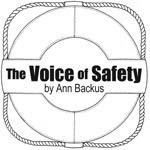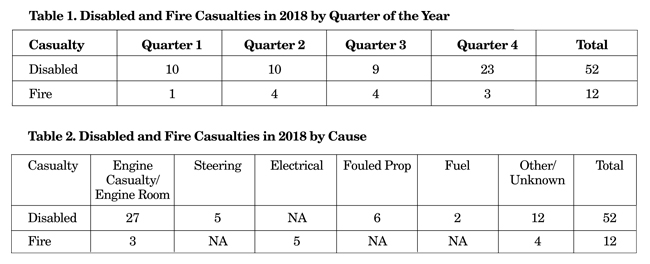Readying for a Safe 2019 Fishing Season
by Ann Backus, MS

For this article, I have been obsessed with the idea that our unusual “freeze-thaw” winter may have played havoc with fuel lines, fuel, valves and seals. As April is a time when some fishermen ready their boats for the next lobstering season, I thought it important to offer some “coming out of storage” suggestions. I analyzed the USCG District 1 data for 2018 to see if there were any patterns of casualties we might discern from this post-winter time last year that might help us act strategically to decrease the risk of post-winter casualties in 2019.
As you can see from the 2018 data presented below for casualties labelled “disabled” and “fire” this second quarter of the year is a rather normal quarter as far as the year goes for these casualties. The “disabled” casualties are roughly equally distributed across quarters 1, 2, and 3 while the “fire” casualties are roughly equally distributed across quarters 2, 3, and 4. These distributions suggest that the deep winter months seem not to have had much impact on disabled and fire casualties in 2018.

However, when we break out these USCG District 1 data by cause we get a hint of the major causes of these casualties which can help us target the areas that need special attention.
Thirty of the 64 disabled and fire causes — or nearly 50% — are associated with the engine or engine room.
Risk mitigation regarding the engine and engine room
The following are some measures fishermen can take to help reduce casualties related to the engine and engine room.
• Leaks: Visually Inspect fuel lines for leaks and inspect undersides of lines with finger for rough spots or breaks. These lines may “age” in freeze-thaw cycles.
• Filters: Check and replace air, fuel, and oil filters routinely according to the manufacturer’s specifications.
• Corrosion: Check for corrosion on machinery, electrical (and battery) contacts, and hose clamps.
• Fluid Levels: Replace any fluids that were drained before storage; check oil, fuel, coolant, etc. levels and confirm that sight gauges are accurate.
• Lubrication: Grease bearings and linkages.
• Hose connections: Inspect the integrity of the hose under the hose clamps and secure all hose connections with two clamps, making sure they are tight. Replace corroded hose clamps.
• Battery: Check for corrosion on the contacts; reconnect battery and check charge.
• Engine running: Listen for smooth running; look/listen for air/fuel leaks; inspect for exhaust leaks and inspect exhaust emissions for unexpected color.
• Engine room: Keep a clean room. Remove or properly store flammable liquids; remove oily rags and sources of ignition. Do not store immersion suits near engine or petroleum products.
• Fire extinguishers or fire suppression system: Make sure they are serviceable and meet USCG requirements in terms of number and type.
Risk mitigation regarding electrical issues and steering
Thinking about electrical issues, contacts are subject to corrosion during storage and should be checked. All wiring should be checked for integrity in the event that small animals or wear and tear have compromised the insulation. With the large number of electronic instruments on board these days, checking electrical wiring could be a substantial task, but presumably all of you know where the potential problems are on your boats.
With respect to steering, the database does not specify where in the steering system the fault occurred. Knowing that, of the five steering casualties, two were towed to port, two were escorted to port and one returned to port, we can guess there were several different problems and certainly different levels of severity. According to the Maintenance Checklist (Commercial Fisheries News, Dec. 2015) described by Fred Mattera, it is important to inspect monthly “the condition of the steering gear, rudder, packing gland, bearings, and bearings and bushings on hydraulic arms.” This same checklist suggests a quarterly check of zincs, propeller, and rudder.
Readiness for the season after the winter includes the above preventive measures plus ensuring that this season’s crew knows how to make a MAYDAY call, can find and operate the fire extinguishers or fire suppression system, and can properly set-up and implement a tow. Twenty-two of the 27 disablements resulting from engine problems required a tow back to port from a Samaritan, USCG vessel or a professional sea tow company.
Whether you are readying your boat for a new fishing season or continuing a season you started earlier – please think about the above risk mitigation strategies and have a safe 2019!
Ann Backus, MS is an Instructor in Occupational Health at Harvard School of Public Health, 665 Huntington Ave., Boston MA 02 5, 617-432-3327, abackus@hohp.harvard.edu.
